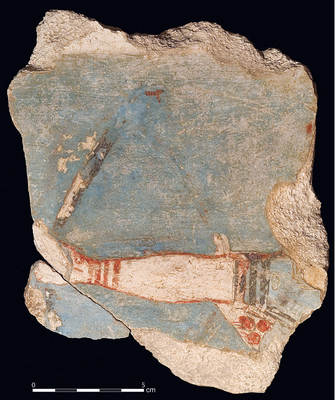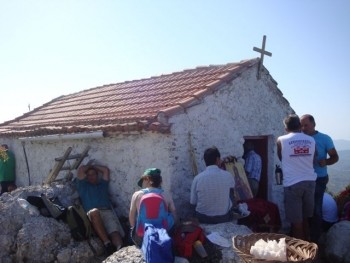 Abstract
Abstract
The authors interpret two joining pieces of a brightly colored wall painting found at the Palace of Nestor in 1939. The fragment, removed from the walls of the palace prior to its final destruction, represents part of an archer, probably female. Alternative reconstructions are offered. Artistic methods and constituents of the plaster and paint are studied by XRD, PIXE-alpha analysis, XRF, SEM-EDS, PY/GC-MS, and GC-MS. Egyptian blue pigment was extensively employed. Egg was used as a binder for the pigments in a tempera, rather than a fresco, technique. The identification of individualized painting styles may make it possible to assign groups of wall paintings to particular artists or workshops.
Restudy of the many published and unpublished wall-painting fragments from the Palace of Nestor in Pylos that are stored in the Chora Museum began in 2000.1 By 2002 it was possible to make a full assessment of the corpus and to define directions for future work. In the course of earlier examinations and the systematic arrangement of wall paintings in new storage cabinets, an unpublished piece of special interest was discovered.....
Download the File
 Abstract
Abstract
 Μέχρι τις 20 Αυγούστου, ζητεί με κατεπείγουσα εγκύκλιό του το υπουργείο Διοικητικής Μεταρρύθμισης και ο υπουργός Αντώνης Μανιτάκης από τα υπουργεία,
τις αποκεντρωμένες διοικήσεις, τις ανεξάρτητες Αρχές και τις ΔΕΚΟ, να
αποστείλουν στοιχεία με τις εκτιμήσεις για τις αποχωρήσεις προσωπικού
από το στενό και ευρύτερο δημόσιο τομέα την επόμενη τριετία.
Μέχρι τις 20 Αυγούστου, ζητεί με κατεπείγουσα εγκύκλιό του το υπουργείο Διοικητικής Μεταρρύθμισης και ο υπουργός Αντώνης Μανιτάκης από τα υπουργεία,
τις αποκεντρωμένες διοικήσεις, τις ανεξάρτητες Αρχές και τις ΔΕΚΟ, να
αποστείλουν στοιχεία με τις εκτιμήσεις για τις αποχωρήσεις προσωπικού
από το στενό και ευρύτερο δημόσιο τομέα την επόμενη τριετία.
